Nuggets
From Oxford Languages and Google: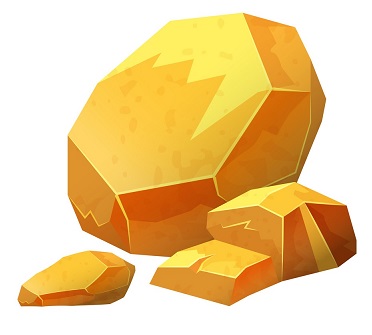
Nugget: /ˈnʌɡɪt/ (noun)
- a small lump of gold or other precious metal found ready-formed in the earth.
- a small chunk or lump of another substance.
While Solomon is a valuable source of Masonic material, this page is for contributions by Brethren of the Andrew Marvell Lodge 5642 and elsewhere. Sometimes the nuggets are published with the summons, sometimes they are delivered in Open Lodge. All Brethren are invited to contribute to this page.
The Order of the Garter
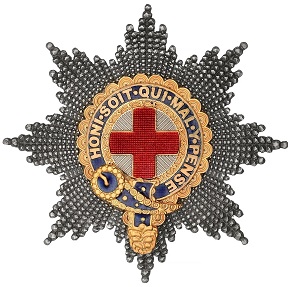 The Masonic Apron is an honourable badge, "more antient than the Golden Fleece or the Roman Eagle, more honourable than the Star and Garter".This was questioned in a rehearsal, and while the hyperbole was accepted as such, it was remarked that "The 'Star and Garter' is the name of a pub."
The Masonic Apron is an honourable badge, "more antient than the Golden Fleece or the Roman Eagle, more honourable than the Star and Garter".This was questioned in a rehearsal, and while the hyperbole was accepted as such, it was remarked that "The 'Star and Garter' is the name of a pub."
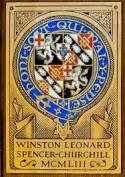 This is true. Many hotels and inns throughout the country bear this name which stems from the royal insignia of the Garter which depicts both items. The badge of the chivalric order without the surrounding star may be seen embroidered on the left shoulder of the blue velvet mantle of a Knight oif the Order, worn on ceremonial occasions, but the smaller version depicted here is more generally known, with the sovereign's star. Members of the Order may encircle their heraldic arms with the Garter, An actual garter is worn ceremonially by those entitled to it on the left calf, a buckled dark-blue velvet strap carrying the motto in gold letters. The colour and style has varied through the centuries.
This is true. Many hotels and inns throughout the country bear this name which stems from the royal insignia of the Garter which depicts both items. The badge of the chivalric order without the surrounding star may be seen embroidered on the left shoulder of the blue velvet mantle of a Knight oif the Order, worn on ceremonial occasions, but the smaller version depicted here is more generally known, with the sovereign's star. Members of the Order may encircle their heraldic arms with the Garter, An actual garter is worn ceremonially by those entitled to it on the left calf, a buckled dark-blue velvet strap carrying the motto in gold letters. The colour and style has varied through the centuries.
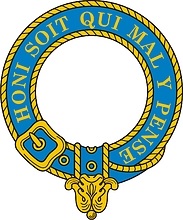 Not all Masonic rituals mention the Star in this context, but reference to the Garter appears in many first-degree workings as it is a symbol of honour. There are different legendary explanations for the origin of the Order, but the most popular is that of the Countess of Salisbury, who was dancing with King Edward at a court ball in Calais (some versions say Windsor Castle) in the 1340s when her garter slid to the ground. The king stooped and picked it up, and several dancing couples nearby snickered, assuming that the dropping of the garter had been deliberate. Angered that an innocent girl should be discredited by base assumptions, the king turned to face them and said "Honi soit qui mal y pense!" - Shame to you that think ill of it. An
Not all Masonic rituals mention the Star in this context, but reference to the Garter appears in many first-degree workings as it is a symbol of honour. There are different legendary explanations for the origin of the Order, but the most popular is that of the Countess of Salisbury, who was dancing with King Edward at a court ball in Calais (some versions say Windsor Castle) in the 1340s when her garter slid to the ground. The king stooped and picked it up, and several dancing couples nearby snickered, assuming that the dropping of the garter had been deliberate. Angered that an innocent girl should be discredited by base assumptions, the king turned to face them and said "Honi soit qui mal y pense!" - Shame to you that think ill of it. An 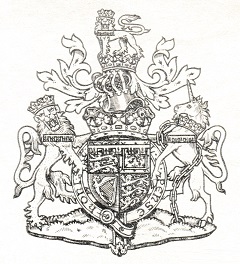 older translation is given as Evil be to him who evil thinketh.
older translation is given as Evil be to him who evil thinketh.
Appointments to the ancient Order at at the sole discretion of the Sovereign, and are usually in recognition of a national contribution, public service or personal service to the Sovereign. Winston Churchill was invested as a Knight of the Garter, the highest ranking British order of knighthood in 1953.
The garter features in some other Masonic Orders - it surrounds the Knight Templar mantle badges, for example, but every Master Mason in the UGLE possesses a certificate on which the arms of the Grand Master, surrounded by the Garter are depicted.
So when the ritual regarding the masonic apron is delivered, might I suggest a slight pause, or virtual comma, after the word "star", and before "and garter" even though they are depicted together surrounding the cross of St George in this article?
ERW
Artificial Intelligence
W Bro Barry Kensett emailed me to say he had requested an AI rendition of a grace before meal, here it is slightly modified for Masonic purposes, but worthy, I think, of attention:
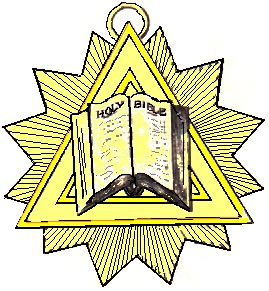 Almighty and eternal God, GAOTU, we, Thy unworthy servants, assembled in this lodge, do implore Thy blessings upon us and upon this food which we are about to receive.
Almighty and eternal God, GAOTU, we, Thy unworthy servants, assembled in this lodge, do implore Thy blessings upon us and upon this food which we are about to receive.
Grant us, we pray, the wisdom to know the truth, the courage to defend it, and the grace to practice it in our daily lives. May the bonds of friendship and brotherhood which unite us in this lodge be strengthened by Thy divine influence, and may we ever be mindful of our duties to Thee, to each other, and to all mankind.
Grant us a mind to think, a heart to love, and a hand to serve; and may the teachings of this lodge, and the practice of its virtues, help us to do Thy will, both here and in the world to come.
So mote it be.
He then asked for the mechanical mind's take on the working tools and elicited the following response:
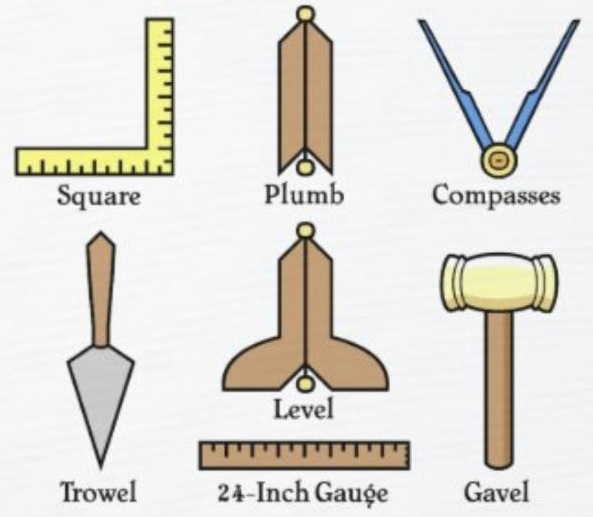 The Masonic working tools are symbolic implements used in Freemasonry to teach moral lessons and to represent various virtues. These tools are commonly used in ritualistic ceremonies and serve as allegorical devices to instruct members in the teachings of the fraternity.
The Masonic working tools are symbolic implements used in Freemasonry to teach moral lessons and to represent various virtues. These tools are commonly used in ritualistic ceremonies and serve as allegorical devices to instruct members in the teachings of the fraternity.
The specific tools used can vary between Grand Lodges and jurisdictions, but common examples include:
The Square: symbolizes morality and represents the importance of fairness, honesty, and integrity.
The Compass: symbolizes the importance of circumscribing one's desires and keeping one's passions within bounds.
The Level: symbolizes equality and represents the importance of treating all people with equal respect and dignity.
The Plumb Line: symbolizes rectitude of conduct and represents the importance of living an upright and moral life.
The Trowel: symbolizes the importance of spreading love, friendship, and charity.
These tools serve as a reminder of the values and principles that Freemasons strive to live by, and they are often used in Masonic ritual and ceremony to impart moral lessons and to foster self-improvement.
I reponded to his email saying I thought the Artificial Intelligence's version was a useful Mentoring Tool, clarifying syntax and getting the meaning over, less eloquently but more incisively. I'd be interested to know what the Brethren think!
Thanks, Barry!
ERW (Web editor)
Past Master's Jewel
The Past Master's Jewel indicates that the recepient has not only served the Lodge for a year in the Master's Chair but is now figuratively able to build complex constructions using the 47th proposition of Euclid.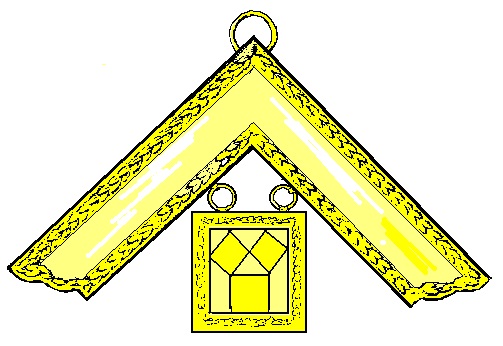 (This is the Pythagorean theorum that in a right-angled triangle, the square of the hypotenuese is equal to the sum of the square of the other two sides.) The jewel depicts a square - the emblem of the Worshipful Master, but now adorned with one of the most important principles of geometry. It indicates that the Past Master has figuratively learned how to make complex constructions from the simple angle of 90o. It symbolises the knowledge and learning gained from his service to the Craft.
(This is the Pythagorean theorum that in a right-angled triangle, the square of the hypotenuese is equal to the sum of the square of the other two sides.) The jewel depicts a square - the emblem of the Worshipful Master, but now adorned with one of the most important principles of geometry. It indicates that the Past Master has figuratively learned how to make complex constructions from the simple angle of 90o. It symbolises the knowledge and learning gained from his service to the Craft.
The 47th proposition has been used in Masonic symbolism as early as 1735.
Eddie Wildman
The Office of Steward
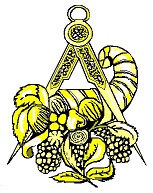 Generally speaking, the first office held by a Brother is that of Steward. His duties include providing refreshment after a Masonic meeting, which nowadays involves serving at the tables. In the past, at Dagger Lane and other venues, the Stewards would eat in a separate room, having served the Brethren at the Festive Board. As most of them were newly made Brethren, they seized the opportunity of interacting with their peers and asking questions about Freemasonry from the more experienced Stewards, using this more informal opportunity to learn about the Craft and the people in it. The bar was staffed by Stewards. Health and safety regulations have made this impossible nowadays, so the Stewards eat with the rest of the Brethren, though it is expected that they assist in dishing out the food and taking the plates away.
Generally speaking, the first office held by a Brother is that of Steward. His duties include providing refreshment after a Masonic meeting, which nowadays involves serving at the tables. In the past, at Dagger Lane and other venues, the Stewards would eat in a separate room, having served the Brethren at the Festive Board. As most of them were newly made Brethren, they seized the opportunity of interacting with their peers and asking questions about Freemasonry from the more experienced Stewards, using this more informal opportunity to learn about the Craft and the people in it. The bar was staffed by Stewards. Health and safety regulations have made this impossible nowadays, so the Stewards eat with the rest of the Brethren, though it is expected that they assist in dishing out the food and taking the plates away.
The Steward’s emblem is a cornucopia. The word derives from the Latin cornu, meaning horn, (as in Ice-cream cornet) and  copiae, meaning plenty (as in “copious”.) So a cornucopia is a horn of plenty. It is illustrated as a curved, hollow goat’s horn, or horn-shaped basket, always overflowing with fruit and vegetables, corn, grapes, etc.
copiae, meaning plenty (as in “copious”.) So a cornucopia is a horn of plenty. It is illustrated as a curved, hollow goat’s horn, or horn-shaped basket, always overflowing with fruit and vegetables, corn, grapes, etc.
The god Zeus, according to one legend, was fed from the broken-off horn of the goat Amalthaea, his foster mother. She filled the horn with fruits and flowers and presented it to the child-god. This emblem of abundance is a traditional symbol in architecture, art and decoration.
UGLE's Update of the Words
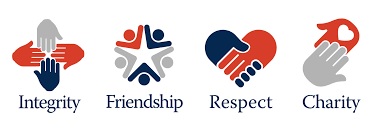
If you ask a Freemason what the order is founded upon, he will tell you “Brotherly Love, Relief and Truth” because that’s part of which we commit to memory.
But to anyone who’s not a Mason, it doesn’t explain very much. So the Big Boys in London – the UGLE – are encouraging us to update the wording when talking to people who are not yet Brethren.
Masonry is about building, of course, and Grand Lodge notes that there are four sorts of building we do, under the headings Integrity, Friendship, Charity and Respect.
Integrity is about building good people.
Friendship is about building together.
Respect is about building unity, bringing people together regardless of race, religion or culture,
And Charity is about building compassion.
That’s what we’re about.
Eddie Wildman
The Missing Working Tool
By W Bro Barry Kensett PPGSwdB, Lodge Mentor
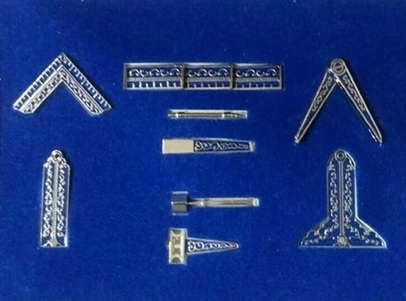 As a Master Mason passes through the three degrees the working tools of a freemason are explained to him, these are shown above and are the square, level, 24” gauge, pencil, chisel, mallet, skirret and chalk line, compasses and level.
As a Master Mason passes through the three degrees the working tools of a freemason are explained to him, these are shown above and are the square, level, 24” gauge, pencil, chisel, mallet, skirret and chalk line, compasses and level.
We may surmise that an operative mason of olden days carried these tools around the country in his knapsack and some even say that these are the genuine secrets of a Master Mason but that is open for debate.
There is however one necessary item missing from masonic teaching.
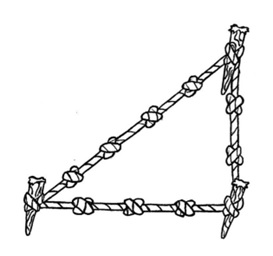
When laying out the foundations of an intended structure the Master Mason must first lay lines to show the location of the walls. It is important that the corners of the building are at right angles
How was this achieved? The square is not large enough for this purpose. The answer lies in the teachings of Pythagoras which we all learnt at school and one important element of his teaching results in the fact that a triangle with sides of three, four and five units will be a right angled triangle. It doesn’t matter what the units are, cubits, yards whatever it all works The operative mason therefore carried in his knapsack a knotted rope of the form illustrated below which enables him to lay out perfect right angles. The distances between the knots must all be equal.
W Bro Barry Kensett, PPGSwdBr
.jpg)
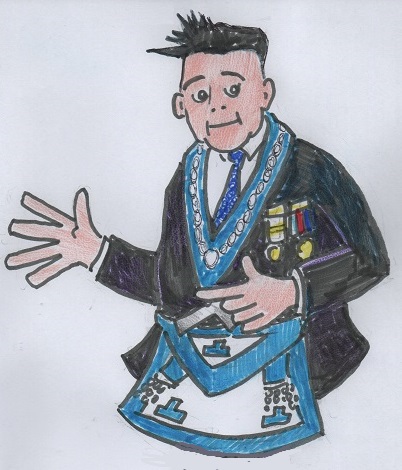
![]()

 The Masonic Apron is an honourable badge, "more antient than the Golden Fleece or the Roman Eagle, more honourable than the Star and Garter".This was questioned in a rehearsal, and while the hyperbole was accepted as such, it was remarked that "The 'Star and Garter' is the name of a pub."
The Masonic Apron is an honourable badge, "more antient than the Golden Fleece or the Roman Eagle, more honourable than the Star and Garter".This was questioned in a rehearsal, and while the hyperbole was accepted as such, it was remarked that "The 'Star and Garter' is the name of a pub." This is true. Many hotels and inns throughout the country bear this name which stems from the royal insignia of the Garter which depicts both items. The badge of the chivalric order without the surrounding star may be seen embroidered on the left shoulder of the blue velvet mantle of a Knight oif the Order, worn on ceremonial occasions, but the smaller version depicted here is more generally known, with the sovereign's star. Members of the Order may encircle their heraldic arms with the Garter, An actual garter is worn ceremonially by those entitled to it on the left calf, a buckled dark-blue velvet strap carrying the motto in gold letters. The colour and style has varied through the centuries.
This is true. Many hotels and inns throughout the country bear this name which stems from the royal insignia of the Garter which depicts both items. The badge of the chivalric order without the surrounding star may be seen embroidered on the left shoulder of the blue velvet mantle of a Knight oif the Order, worn on ceremonial occasions, but the smaller version depicted here is more generally known, with the sovereign's star. Members of the Order may encircle their heraldic arms with the Garter, An actual garter is worn ceremonially by those entitled to it on the left calf, a buckled dark-blue velvet strap carrying the motto in gold letters. The colour and style has varied through the centuries. Not all Masonic rituals mention the Star in this context, but reference to the Garter appears in many first-degree workings as it is a symbol of honour. There are different legendary explanations for the origin of the Order, but the most popular is that of the Countess of Salisbury, who was dancing with King Edward at a court ball in Calais (some versions say Windsor Castle) in the 1340s when her garter slid to the ground. The king stooped and picked it up, and several dancing couples nearby snickered, assuming that the dropping of the garter had been deliberate. Angered that an innocent girl should be discredited by base assumptions, the king turned to face them and said "Honi soit qui mal y pense!" - Shame to you that think ill of it. An
Not all Masonic rituals mention the Star in this context, but reference to the Garter appears in many first-degree workings as it is a symbol of honour. There are different legendary explanations for the origin of the Order, but the most popular is that of the Countess of Salisbury, who was dancing with King Edward at a court ball in Calais (some versions say Windsor Castle) in the 1340s when her garter slid to the ground. The king stooped and picked it up, and several dancing couples nearby snickered, assuming that the dropping of the garter had been deliberate. Angered that an innocent girl should be discredited by base assumptions, the king turned to face them and said "Honi soit qui mal y pense!" - Shame to you that think ill of it. An  older translation is given as Evil be to him who evil thinketh.
older translation is given as Evil be to him who evil thinketh. Almighty and eternal God, GAOTU, we, Thy unworthy servants, assembled in this lodge, do implore Thy blessings upon us and upon this food which we are about to receive.
Almighty and eternal God, GAOTU, we, Thy unworthy servants, assembled in this lodge, do implore Thy blessings upon us and upon this food which we are about to receive. The Masonic working tools are symbolic implements used in Freemasonry to teach moral lessons and to represent various virtues. These tools are commonly used in ritualistic ceremonies and serve as allegorical devices to instruct members in the teachings of the fraternity.
The Masonic working tools are symbolic implements used in Freemasonry to teach moral lessons and to represent various virtues. These tools are commonly used in ritualistic ceremonies and serve as allegorical devices to instruct members in the teachings of the fraternity.
 Generally speaking, the first office held by a Brother is that of Steward. His duties include providing refreshment after a Masonic meeting, which nowadays involves serving at the tables. In the past, at Dagger Lane and other venues, the Stewards would eat in a separate room, having served the Brethren at the Festive Board. As most of them were newly made Brethren, they seized the opportunity of interacting with their peers and asking questions about Freemasonry from the more experienced Stewards, using this more informal opportunity to learn about the Craft and the people in it. The bar was staffed by Stewards. Health and safety regulations have made this impossible nowadays, so the Stewards eat with the rest of the Brethren, though it is expected that they assist in dishing out the food and taking the plates away.
Generally speaking, the first office held by a Brother is that of Steward. His duties include providing refreshment after a Masonic meeting, which nowadays involves serving at the tables. In the past, at Dagger Lane and other venues, the Stewards would eat in a separate room, having served the Brethren at the Festive Board. As most of them were newly made Brethren, they seized the opportunity of interacting with their peers and asking questions about Freemasonry from the more experienced Stewards, using this more informal opportunity to learn about the Craft and the people in it. The bar was staffed by Stewards. Health and safety regulations have made this impossible nowadays, so the Stewards eat with the rest of the Brethren, though it is expected that they assist in dishing out the food and taking the plates away. copiae, meaning plenty (as in “copious”.) So a cornucopia is a horn of plenty. It is illustrated as a curved, hollow goat’s horn, or horn-shaped basket, always overflowing with fruit and vegetables, corn, grapes, etc.
copiae, meaning plenty (as in “copious”.) So a cornucopia is a horn of plenty. It is illustrated as a curved, hollow goat’s horn, or horn-shaped basket, always overflowing with fruit and vegetables, corn, grapes, etc.

